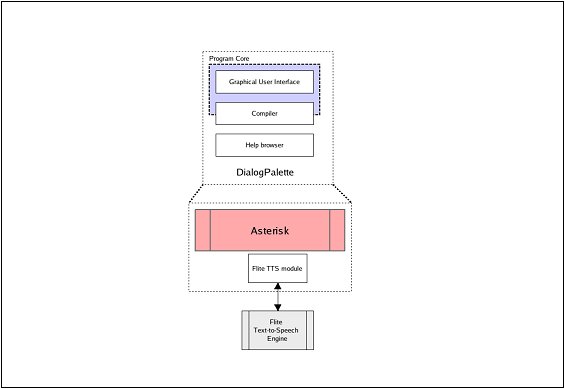Meraka Openphone:Technology: Difference between revisions
| Line 16: | Line 16: | ||
Hardware | ==Hardware and software requirements== | ||
Personal Computer (referred to as the Asterisk server): Pentium 3, 265MB memory | |||
Personal Computer (referred to as the Asterisk server) Pentium 3, 265MB memory | Operating System: Linux | ||
Operating System Linux | Asterisk: v1.0 series or higher (Download available from http://www.asterisk.org) | ||
Asterisk v1.0 series or higher Download available from http://www.asterisk.org | Telephony card: Asterisk compatible (Only required for telephony access and not for VoIP. There are however costs involved in acquiring such a card) | ||
QT Library: v3.3 or higher GPL/Enterprise version | |||
Telephony card Asterisk compatible Only required for telephony access. There are however costs involved in acquiring such a card | Python: V2.4.1 or highter | ||
QT Library | TTS(Optional): Flite or Festival (Site to be confirmed) | ||
Python V2.4.1 or highter | DialogPalette: http://dialogPalette.sf.net | ||
TTS(Optional) Flite or Festival Site to be confirmed | Uninterrupted power supply (This is optional, but recommended in areas where electricity supply is unreliable) | ||
DialogPalette | |||
Uninterrupted | |||
Revision as of 15:16, 4 September 2007
OpenPhone Components
The following figure depicts the OpenPhone system.
The core of OpenPhone is the Asterisk PABX open source system (www.asterisk.org). Asterisk does voice over IP in many protocols, and can interoperate with almost all standards-based telephony equipment using relatively inexpensive hardware. DialogPalette is a graphical user interface to Asterisk and allows a user to easily create telephony applications. It can be conceptualised as an authoring tool for telephony applications. The Asterisk system has been expanded to use FLITE, a text to speech (TTS) engine designed by Carnegie Mellon University (http://www.speech.cs.cmu.edu/flite/index.html) . FLITE enables the OpenPhone system to convert text to speech using a computer generated voice.
The primary role of DialogPalette is to act as an authoring tool which allows an information provider to design an information dissemination application. The information provider can record the prompts for the various phases in multiple languages. The application designer also has the choice of using the text to speech (TTS) to record prompts in a language of choice. The application design will be guided by the use of templates.
The information users will access the designed solution by phoning a number. This number will ideally be toll-free or sponsored. The user will listen to the voice prompts and interact with the system by entering the requested key presses.
The latest version of Dialogue Palatte can be downloaded here.
Hardware and software requirements
Personal Computer (referred to as the Asterisk server): Pentium 3, 265MB memory Operating System: Linux Asterisk: v1.0 series or higher (Download available from http://www.asterisk.org) Telephony card: Asterisk compatible (Only required for telephony access and not for VoIP. There are however costs involved in acquiring such a card) QT Library: v3.3 or higher GPL/Enterprise version Python: V2.4.1 or highter TTS(Optional): Flite or Festival (Site to be confirmed) DialogPalette: http://dialogPalette.sf.net Uninterrupted power supply (This is optional, but recommended in areas where electricity supply is unreliable)
